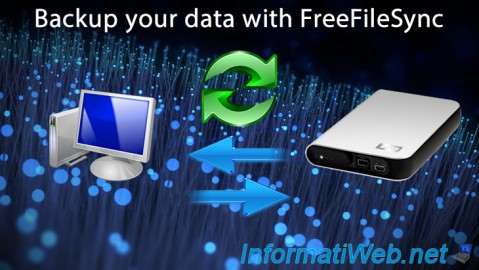- Backup
- FreeFileSync
- 22 August 2016 at 12:20 UTC
-

- 1/2
Currently, we use more and more websites, programs, ... and we store more and more files on our hard drives.
One part of them is very important for most of you and this is even more the case for programmers, developers, ... Indeed, the loss of a source code of a program or of a website can be catastrophic for its author. It's therefore important to make a backup of these data to have a copy in case of problems with your hard drive or your computer or in case of theft.
In this article, we will explain how to back up your data and what problems might occur if you don't use a backup software.
Then, we will also present FreeFileSync which is a free, open-source, very efficient, very flexible and multi-platform (compatible with Windows, Linux, Mac, ...) backup program.
Indeed, with FreeFileSync, you can back up your data faster and smarter.
- Problematics of conventional backup
- How to backup your data ? In which direction ?
- FreeFileSync download
- FreeFileSync features
1. Problematics of conventional backup
When you want to backup your data without a program, there are many problems occurring over the years.
In fact, most people do copy/paste of files and/or folders they want to backup to an external hard drive or other.
This is problematic because :
- old files/folders that have been deleted in the meantime will not be deleted in the backup. Thus, the backup will take more and more space unnecessarily.
And if you do it with the source code of a program and/or a website, this may cause problems when you will want to restore the backup. - the operating system (Windows, Linux, Mac OS X, ...) will rewrite ALL data on the destination drive (external hard drive, USB key, ...). Which takes much more time and it abyss much more your external media. Indeed, if we take the example of the flash memory of USB flash drives and SSD, you must know that flash memory chips have a limited number of read / write (enough to enjoy it for years, but here you reduce this time unnecessarily at each backup).
- it is constraining and risky : in fact, if you want to back up your data regularly, you'll soon tired of doing copy/paste repeatedly. And it is risky, because if you transfer data in the wrong direction, it may cause a deletion of your latest changes. This is a nightmare for programmers, especially if the erased code was complicated to write.
- it isn't flexible. No filter, ...
In short, backup softwares are essential to correctly and smartly backup your data and preserving your external media ...
2. How to backup your data ? In which direction ?
It's a good question.
Indeed, there are different ways to backup your data and different directions.
Then, you may want to ignore specific folders and/or files. To do this, you can use filters.
2.1. Different ways
Currently, there are many ways to backup your data and as a normal user, you have :
- the backup to an external media : an USB key, an external hard drive, ...
- the backup to a network location : a network share (of a PC under Windows, Linux or other), a NAS, ...
- the backup to the cloud with Google Drive, Dropbox, Hubic, ...
Each type of backup has its advantages and disadvantages as explained at "Make backups of your data" section of our article "Protect yourself against viruses, hackers and traps present on Internet".
2.2. Possible directions
When you want to backup your data, there are many possible directions :
- source to destination (backup)
- destination to source (restoration)
- or 2 directions simultaneously (synchronization)
Depending on the data to backup and the use that you will make of this backup, you will choose one of these solutions.
However, as FreeFileSync is very flexible, you can also select multiple directions for a single backup.
Indeed, for each folder to sync, you can choose a particular direction for the backup process.
2.3. Filters
This is expressions with special characters such as * meaning "any character" and thus enabling you to ignore specific sub-folders and/or files when you run the backup process of your data.

You must be logged in to post a comment